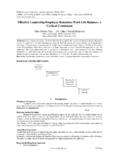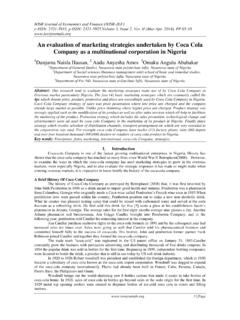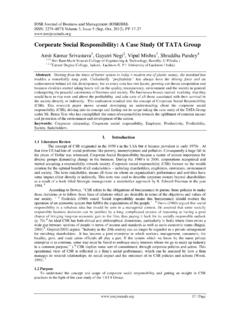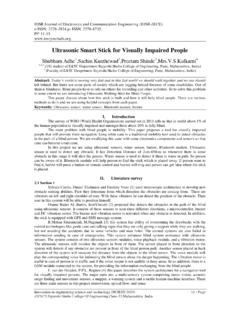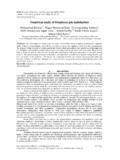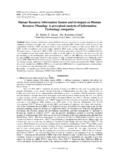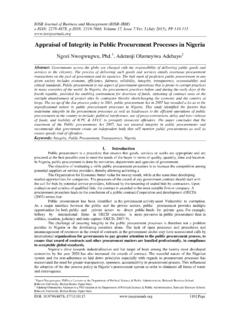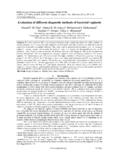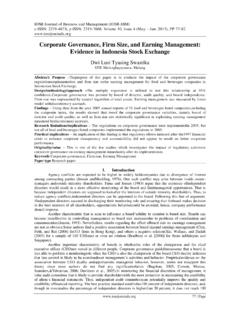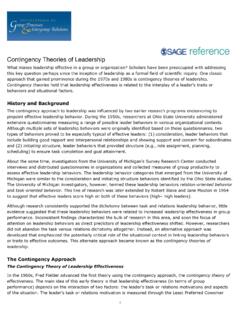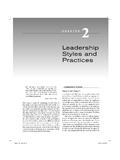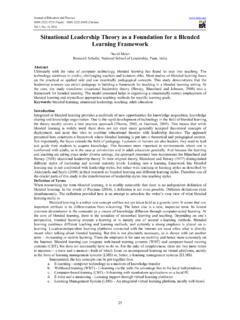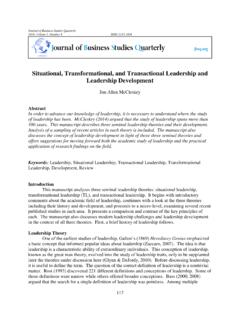Transcription of Situational And Contingency Theories Of Leadership: Are ...
1 IOSR Journal of Business and Management (IOSR-JBM) ISSN: 2278-487X. Volume 4, Issue 3 (Sep-Oct. 2012), PP 13-17 13 | Page Situational And Contingency Theories Of leadership : Are They The Same? Dr (Mrs.) Otaroghene Peretomode Department of Petroleum Marketing & Business Studies, Petroleum Training Institute, Effurun, Dleta State, Nigeria. Abstract: This paper is a positional, theoretical paper that explains comprehensively the all powerful but ambiguous concept of leadership , highlights its features and the categorization of its major theoretical approaches. It distinguishes clearly the two categorizations that neophytes and even scholars often used interchangeable as if both are the same. These broad categories are the Situational and Contingency Theories of leadership . This distinction, it is believed, enables students to understand clearly the Theories under each category but more importantly, it helps officials in Ministries of Education in developing countries to act most appropriately in a timely manner in intervening in worsening school administration with success in view.
2 Key Concepts; Administration, Consideration, Contingency Theories , leadership , Management, Maturity level, Situational models, the behavioural approach, the great man approach, the style approach, task oriented, initiating structure, I. Introduction In Africa, there is the popular saying that the golden fish has no place to hide, so also is the concept of leadership . leadership as a concept is dynamic, fluid and complex hence in spite of its popularity, wide use and over 40,000 studies and writings on the subject, there is yet to emerge a universally accepted definition. Its popularity among the learned, literate and illiterate , is due to the fact that the success or failure of any nation or organization be it religious, profit or not-for - profit, public or private, is attributed to good leadership or poor leadership . The failure to have one generally accepted definition of the term could also be attributed to the argument made by McNamara (1992, 2009) that the concept of leadership is like a big elephant and each person standing around it has his/her own unique view, and each person feels very strongly about his/her own view.
3 Similarly, an anonymous writer says leadership is like pornography, hard to define but easy to recognize . To Bennis (1999), leadership is like beauty, it is hard to determine, but you know it when you see it. In this paper, we will briefly explain the concept of leadership , highlight its features, identify the different broad categories of leadership Theories and then attempt to examine whether or not there are distinguishing characteristics between the Situational category of leadership Theories and that referred to as Contingency leadership Theories . Attempt will also be made to apply both categories to a hypothetical given school situation to determine the suitability and workability of each. First, let us examine the concept called leadership . II. leadership : Meaning and Features: The concept of leadership can be traced to the Anglo Saxon lad or laedan which means a path, a way, to lead or give a sense of direction.
4 On this basis, leadership can be said to imply the one who shows others the way . As Peretomode (2012) rightly argued, this explanation derived from the root word gives insight into what leadership is all about. leadership , therefore, can be defined comprehensively and comprehensibly as: an art or process by which a member of a group or organization persuades, inspires, influences the attitudes, behaviour and actions of others and directs their activities so that the group or organization members work willingly, cooperatively and enthusiastically toward the accomplishment of set goals and a new and improved position (Peretomode, 2012: 10). leadership from this definition is different from management, or administration or the boss the head. It implies that the boss may not necessarily be the leader. This, however, does not preclude the fact that the boss who is the head by virtue of the position he or she occupies cannot transit to become a leader.
5 It points, though to one basic fact of life, that the leader could be a person who does not necessarily occupy a position of power or authority. Such a person may be regarded as the informal leader in the organization. A number of what could be considered as the features of leadership are self evident from the definition given above and that is leadership : Involves other people. Without followers there can be no leader. It entails influence rather than authority It involves showing subordinates / followers the right way to go It focuses on achieving set goals Situational And Contingency Thories Of leadership : Are They The Same? 14 | Page It is an on-going activity; a process. It is continuous. It involves an unequal distribution of influence between the leader and followers/ subordinates. It is thus a social influence relationship. It is a means to an end, rather than an end in itself.
6 It produces positive change/improvement and not concerned with maintaining the status quo. leadership Theories and their Broad categorizations In an effort to provide insight to the study and understanding of the complex phenomenon of leadership , over the years, there have been developed or propounded various perspectives, approaches, models and Theories of leadership . Scholars have also made efforts to classify these Theories in various ways namely; classical, behavioural, Situational , Contingency and emerging or contemporary Theories and more. But while authors easily distinguish clearly between classical, behavioural / style and Situational approaches to the study of leadership , they often do not attempt to make clear the distinction between Situational and Contingency Theories of leadership , For example, Peretomode (1991), Onoyase (1992,2007), Ogunu (2000), Egwuyenga (2002), Lunenbury and Ornstein (2004), Hoy and Miskel (2005) , Nakpodia (2006,2012) did not make efforts to distinguish between Situational and Contingency categories of leadership Theories which are believed to be more robust and therefore preferred to the earlier models of leadership .
7 The failure to make clear the differences between both categories of leadership Theories had led to students, even scholars, using both terms interchangeably as if they are the same, but they are not. Making clear the differences will enable educational managers or educational policy formulators or implementers to take appropriate and timely actions to arrest deteriorating school situations and to be able to turn such ugly situations around for the better, at the shortest possible time. Students of administration and management also need to know the distinction between Situational and Contingency categories of leadership Theories in order to better appreciate and understand each of the Theories under each broad category. The Common Threads A critical examination and analysis of the categories of Situational leadership Theories and that of Contingency leadership approaches show that both categorizes are characterized by at least four common features.
8 These are that: 1. Both categories are extension of behavioural group of leadership models 2. They contend that there is no one best or right way of successfully leading a group or an organization because a leadership style that is effective in one situation may be ineffective or a total failure in another situation. 3. A successful leader in a given situation may become a failure in the same position in the same organization when factors around the situation change. 4. They assume that the effectiveness of leadership styles are determined by factors internal and external to the organization, within the leader and employees or followers and the leaders skills and the maturity levels of followers. The Differences We have explained that there are certain common elements or similarities between Theories broadly classified as Situational and those referred to as Contingency Theories of leadership .
9 Despite this fact, there seems to be two very distinctive characteristics between the two. According to Syque (2007), Situational Theories tend to focus more on the behaviors that the leader should adopt, given the followers behaviour, whereas Contingency Theories take a broader perspective that include Situational factors about leader skills and capability and other variables within the given situation. This author agrees with the explanation put forward by Peretomode (2012) that the difference between Situational and Contingency Theories of leadership is clearer and more meaningful if viewed from the basic assumption that underpin each category in respect to the rigidity or otherwise of leadership styles. Situational Theories presume that leadership style is relatively flexible, and indeed flexible enough for a leader to move along a continuum front and back so as to enable him/her cope with different situations.
10 In effect, the Situational category of leadership Theories claim that it is possible for a dictator or task oriented leader to change his style to become a democratic or employee oriented leader, as the situation changes. The core of the argument therefore, is that effective or successful leaders are those who change their style to fit the situation. Thus, to Situational Theories , effectiveness of leaders depends on successfully diagnosing where subordinates are on the development continuum and adapting their leadership style as necessary. Some Theories of leadership that can be clearly classified under the Situational category are: The Tannenbaum and Schmidst s leadership model The Reddin s -3- theory of leadership The Path Goal Theory of leadership The Hersey and Blanchard Situational leadership Theory. Situational And Contingency Thories Of leadership : Are They The Same?
